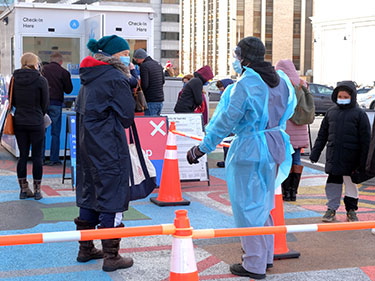News that the COVID-19 omicron variant surge may have peaked in some areas of the U.S. is offering hope. But a closer look at local and regional data shows the wave is far from over, and may be worsening in parts of the country.
Reports of new COVID-19 infections are rapidly falling overall in the U.S., according to The New York Times’ COVID-19 tracker, which uses data from state, local and national health agencies. As of Jan. 25, 650,000 new U.S. cases were reported daily, falling from a mid-January high of more than 806,000 a day.
The decline is not being seen equally in all regions of the country, however. COVID-19 case counts are dropping in the Northeast, mid-Atlantic states, Upper Midwest and other areas, according to the tracker. But the West, South and Great Plains regions continue to show surges of the disease. Alabama and North Dakota are experiencing near-record levels.
Regional differences are not as well represented in a nationwide snapshot, and areas with low vaccination rates and relaxed mitigation measures may have more record-setting days ahead.

Such factors will continue to hinder the nation’s recovery from the pandemic, according to Daniel McQuillen, MD, FIDSA, president of the Infectious Diseases Society of America. Though South Africa, Israel and Britain showed a peak in omicron cases followed by a sharp decline, that pattern likely will not happen in the U.S.
“I think it’s going to be a more bumpy road down, but also regionalized,” McQuillen told The Nation’s Health.
While omicron cases may have peaked in some urban areas, cases are on the rise in many rural communities, county level data and wastewater sampling show. Parts of Oklahoma are showing record increases, for example.
People in rural areas are less likely to be fully vaccinated, which could lead to more severe illnesses and outcomes in those populations. Rural children are likely to be lagging on COVID-19 vaccinations, a Kaiser Family Foundation poll shows. Many rural hospitals are already at capacity, and a further increase could hinder access to care for all residents, not just those with COVID-19.
Even with the localized case declines, hospitalizations and deaths remain high nationally. As of Jan. 25, deaths from COVID-19 across America were up 35% compared to two weeks ago, averaging about 2,300 a day.
McQuillen is hopeful that spring will offer a slight reprieve from the past two years of the pandemic. But come fall and winter, “I am not sure what will happen,” he said. “It could be great, or another variant could appear that is worse."
People line up for COVID-19 testing in Arlington, Virginia, on Jan. 15. Photo by Jeff Vincent, courtesy Flickr/Creative Commons